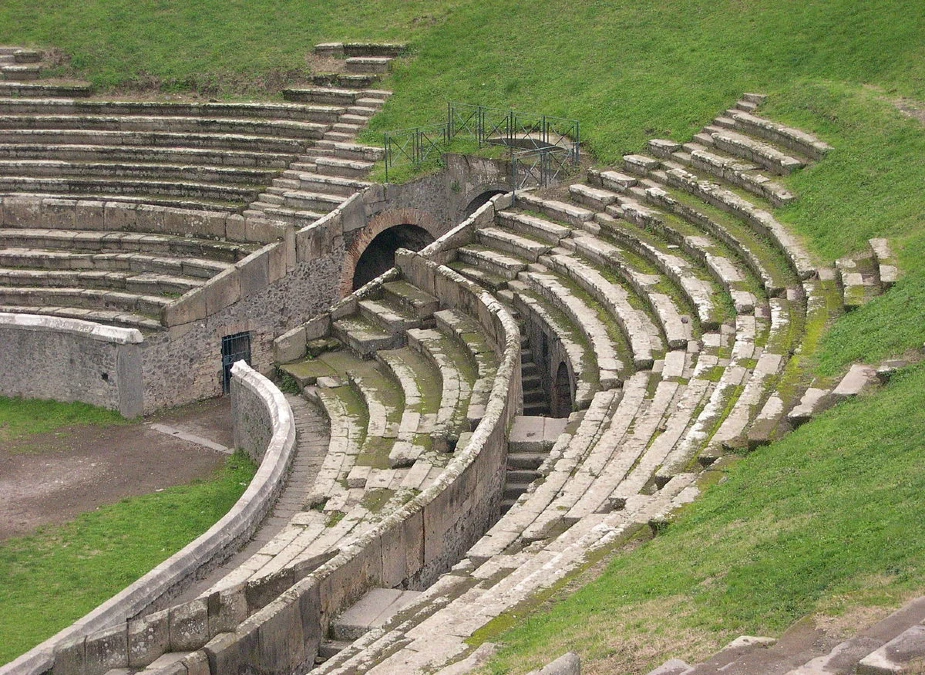The amphitheater is an entertainment complex located inside Pompeii, near Naples.
This engineering marvel hosted gladiatorial battles, theatrical performances, and thrilling public spectacles in its time.
Built around 79 BC, it holds many secrets, ranging from seating arenas to its imposing facade.
This article will explore everything about the Amphitheater, from its historical significance to what you can do there and more.
Historical Background
Amphitheaters were built to represent popular entertainment forms like gladiator battles and animal contests.
It is a freestanding, open-air structure with a central arena flanked by tiers of concentric seats.
Initially designed with wooden elements, it evolved into a concrete behemoth with the introduction of concrete.
It could accommodate up to 24,000 visitors in a grand setting.
The majestic yet functional architecture was intended to provide an immersive experience for the spectators.
Design and Access Points

The Amphitheater has an elliptical layout and measures 445 feet by 341 feet (136 meters by 104 meters).
The seating arrangement was divided into three sections: ima cavea (low), media cavea (middle), and summa cavea (upper), catering to various social classes.
A two-meter balustrade separated spectators from the arena’s events.
External staircases led to the seating areas, where city elites used to enter via covered pathways.
Ima cavea was for the lower classes, media cavea for the general population, and summa cavea for the city’s elite.
Rediscovery and Excavation
The excavation of the Pompeii site led to the rediscovery of the Amphitheater in the 18th century.
Systematic excavation efforts were followed by renowned Italian archaeologist Amedeo Maiuri to unearth it without causing damage.
Italian and international universities came together to facilitate surveying and maintenance to ensure its structural integrity
What can you do there?
While standing in the amphitheater, you can imagine the gladiator games and other competitions that used to captivate the audience.
A guided tour can be especially beneficial for understanding the amphitheater’s architectural, cultural, and social significance in Roman society.
You can also photograph Roman architecture in this picturesque setting.
In addition, you can consider the cultural significance of these spectacles and the societal norms of ancient Rome.
Note: If you want to explore the Amphitheater and other Vesuvius park attractions, purchase Pompeii small group guided tour that gives priority access to everything for just € 44
FAQs
1. What events were held at the Pompeii Amphitheater?
Gladiatorial games, circus shows, and other spectacles were popular among the Pompeians at the amphitheater.
2. Is the Pompeii Amphitheater open to visitors today?
Yes, the amphitheater is open to visitors daily, allowing them to discover the historic structure and its grandeur.
3. What is the architectural style of the Pompeii Amphitheater?
The amphitheater has an elliptical shape and a large cavea divided into sections for different social classes.
4. Are guided tours available for the Pompeii Amphitheater?
Yes, you can join small-group guided tours led by expert archaeologists and guides to gain insights into the amphitheater’s historical and cultural significance.
5. What is the best time to visit the Pompeii Amphitheater to avoid crowds?
Early morning and late afternoon visits are ideal for a quieter experience. These times allow visitors to appreciate its historical charm without getting overwhelmed by crowds
6. What makes the Pompeii Amphitheater a must-see attraction in Pompeii?
Its historical significance, architectural majesty, and role in Roman entertainment make it an enticing location for discovering Pompeii’s ancient wonders.
Featured Image: Commons.wikimedia.org




